Hedgerows can be very old – often marking important boundaries. But their most significant features are their aesthetic appeal, and the amount of habitat they provide for various important flora and fauna. Many of the flora and fauna are endangered, and hedgerows are the only habitats in which they can survive.
The law surrounding hedgerows is both vague and complex – something the authorities like to make use of. You can read much more about the subject on Naturenet.
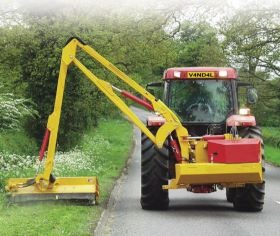 One of the most annoying aspects of hedgerow – and, indeed, any natural area’s – maintenance is the JCB (or tractor)-mounted Hedge Trimmer, like this one.
One of the most annoying aspects of hedgerow – and, indeed, any natural area’s – maintenance is the JCB (or tractor)-mounted Hedge Trimmer, like this one.
Note the idyllic setting… spring or early summer, overhanging trees with blossom. Quiet rural road.
You can almost imagine wood nymphs frolicking naked in the adjoining fields, as local peasants draw water from natural wells or bathe in crystal-clear springs, before heading to the fields to sow their crops.
The reality is somewhat different, though. The picture here – taken from a sales brochure – doesn’t tell the true story. Not by a very long way indeed. After the passing of one of these damned things, it looks like someone has dropped a bomb!
These destructive machines are not just used to mow the grass. They can be used for that, of course, usually after they’ve been adjusted to cut to about 5cm below ground level to make the trim last longer. But they also tend to ‘mow’ anything that gets in their paths, and that includes all kinds of rubbish (i.e. plastic bottles) that the sanitised picture here doesn’t show. They’ll pulverise a Coke bottle, discarded wheel trim, or traffic cone into fragments in seconds – which brings me on to the subject of what they do to hedges.
I must admit that in the past I have been amazed by what local councils – and other "responsible" bodies, such as the National Rivers Authority (NRA) – do when they ‘maintain’ areas which fall under their jurisdiction. Forcing tarmac footpaths through every patch of green is one of my least favourite – how on earth attracting people into the middle of previously inaccessible natural areas (with their bikes, dogs, motorcycles, household waste, and so on) is in any way conducive to ‘conservation’ is a form of logic which escapes me. I think with councils in particular there is a huge chasm separating what they say they will do when they want to be elected, and what they actually do once they have been. So… are you ready for this?
Don’t forget that idyllic scene in the picture from the sales brochure…
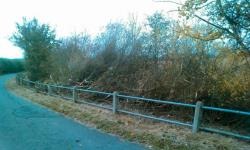 Over the last few days I have driven a number of times down a single track road in Bunny, Nottinghamshire, with pupils. They are "trimming" the hedges.
Over the last few days I have driven a number of times down a single track road in Bunny, Nottinghamshire, with pupils. They are "trimming" the hedges.
The result is shown on the left.
Until they started, the trees were up to that fence. But look more closely and you’ll notice that we aren’t talking about a bit of pruning – this is wholesale destruction.
The picture on below right shows some of the damage and debris in more detail.
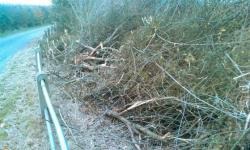 You can see how entire trees have simply been ripped apart – partly by the pneumatic jaws of the trimmer, partly by the sheer incompetence of the driver of the vehicle – who seems to have dragged some of them out of the ground as though he were in a hurry.
You can see how entire trees have simply been ripped apart – partly by the pneumatic jaws of the trimmer, partly by the sheer incompetence of the driver of the vehicle – who seems to have dragged some of them out of the ground as though he were in a hurry.
The trees were probably 20-30 feet high before they were killed.
It isn’t just this one area – a long stretch of the road which is apparently the responsibility of the Council is affected to the same degree (a stretch further down, and m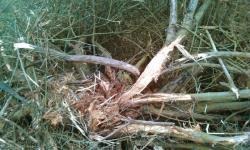 ost of the opposite side of the road, is the responsibility of the local farmer, who makes a somewhat better job of things)..
ost of the opposite side of the road, is the responsibility of the local farmer, who makes a somewhat better job of things)..
This next picture on the left clearly shows soil, where the tree has effectively been uprooted. It’s just been dragged out of the ground.
The tree – a willow – was clearly a mature specimen. The trunk thickness is a guide to that fact.
This next picture, below right, shows the typical damage caused by these devices to smaller branches – even when they are being used correctly. They simply smash the branches apart, and they are hugely 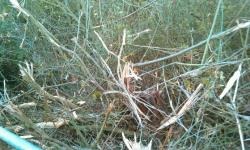 powerful – meaning they can do the same to almost anything that fits between the jaws.
powerful – meaning they can do the same to almost anything that fits between the jaws.
This is why I am against them – because even if they’re being used properly as “trimming devices” they still cause huge damage to the trees they’re used on.
The next picture below shows a tall – but now, very dead – willow tree It just looks like it has been blasted apart.
Even when a tree is left standing, as is the case when it won’t fit the jaws, branches that do fit are torn off, along with long strips of bark. Or the jaws will nip the trunk and shave the bark off one side, which i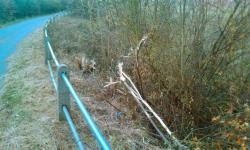 s obviously going to weaken any tree that survives the immediate onslaught.
s obviously going to weaken any tree that survives the immediate onslaught.
Finally, below right, another willow tree. Randomly selected from numerous more destroyed examples, the thickness of the trunk suggest a quite mature specimen.
Again, just look at the thicknesses of those trunks. This is not pruning or trimming. It is tree-felling. Hardly the rural idyll depicted in the brochure, is it?
I have long held the belief that council (and other authorities) workers who operate these machines, chainsaws, strimmers (or any other 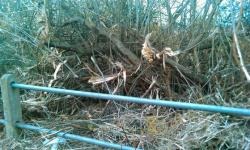 piece of equipment the general public wouldn’t normally have access to) have the kinds of intellects where they really get off on using them. The workers in this case had "NCC" on their backs, which I assume stands for "Nottinghamshire County Council".
piece of equipment the general public wouldn’t normally have access to) have the kinds of intellects where they really get off on using them. The workers in this case had "NCC" on their backs, which I assume stands for "Nottinghamshire County Council".
Ironically, this particular road became overgrown to a significant degree way back in spring. So overgrown, in fact, that it was dangerous to drive down – and yet nobody did anything (well, a farmer did trim his section, and I noticed today that the NCC workers have left that section alone). Also ironically, Nottinghamshire has had a major issue this year with foliage hiding road signs – no one responsible for this serious problem got off their backsides and did what they’re supposed to.
Indeed, the proliferation of those "Your Speed" signs around here has, on occasion, raised smiles with me and my pupils when we have seen them being erected behind trees – thus necessitating pruning (some months later, naturally: it’s a different department) so that the branches don’t trigger the things falsely! No doubt there is some huge bureaucracy shielding any single person from that sort of cock-up, though.
I suppose the obvious conclusion is that complete stupidity obviously doesn’t just drive a tractor with a pneumatic strimmer on it. Stupidity also organises things from behind desks at County Hall (or any other place where responsibility accompanies it).
Less than a month ago, on this same road, I had to slow down to avoid a large grass snake – the first time in my life I have ever seen a live snake in the wild in this country. Yesterday, I saw a stoat (or weasel – I can never tell which, as they go so fast) dart across in front of me. I see various hawks daily, and in spring and summer it is common to end up following a hare as it seeks to find a gap in the hedge (though it shouldn’t have much trouble now). Owls occasional flit across your headlight beams at night. During summer days, bright green cuckoos are often disturbed by passing cars. Nottingham County Council is doing its level best to screw all that up.
Another aspect of these voracious cutting machines is that hedge-trimming is now often done more frequently. What was once a chore is now a doddle for farmers and landowners. As a result, hedgerows consisting primarily of Hawthorn have their new growth removed in early spring (and so look awful for a large part of the time), and then all the berries are removed around September/October – and these are (or were) a food source for some of our native birds. The same applies to hedgerows containing Elderberry – these have weak stems and the thrashing they get up to three times between spring and autumn prevents them being able to produce flowers or fruit. At the moment, most rural roads with hedgerows around here look sterile: all the yellowing leaves have been shaken off and the berries are gone. All that’s left are shattered twigs and geometrically-shaped woody columns for mile after mile.
In defence of farmers, at least they have the sense to fit their machines with the right kind of flail head. You see, those tractor-mounted cutters can have a variety of ‘hammers’ installed which deal with anything from grass up to things the size of cooling towers. Nottinghamshire County Council appears to operate on the ‘one size fits all’ principle, and that’s why its machines can do the kind of damage to whole trees shown in those pictures above.
I wonder if anyone will realise the damage being done before it’s too late? And I wonder if Nottinghamshire County Council actually cares?
Footnote: I reported it to the Council at the time. They responded with a load of guff about "maintenance", as usual, but admitted that they would tidy up the debris. They never did. And that was more than two years ago!